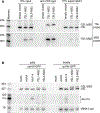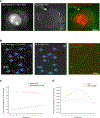Recruitment of 7SL RNA to assembling HIV-1 virus-like particles
- PMID: 29044909
- PMCID: PMC6781622
- DOI: 10.1111/tra.12536
Recruitment of 7SL RNA to assembling HIV-1 virus-like particles
Abstract
Retroviruses incorporate specific host cell RNAs into virions. In particular, the host noncoding 7SL RNA is highly abundant in all examined retroviruses compared with its cellular levels or relative to common mRNAs such as actin. Using live cell imaging techniques, we have determined that the 7SL RNA does not arrive with the HIV-1 RNA genome. Instead, it is recruited contemporaneously with assembly of the protein HIV-1 Gag at the plasma membrane. Further, we demonstrate that complexes of 7SL RNA and Gag can be immunoprecipitated from both cytosolic and plasma membrane fractions. This indicates that 7SL RNAs likely interact with Gag prior to high-order Gag multimerization at the plasma membrane. Thus, the interactions between Gag and the host RNA 7SL occur independent of the interactions between Gag and the host endosomal sorting complex required for transport (ESCRT) proteins, which are recruited temporarily at late stages of assembly. The interactions of 7SL and Gag are also independent of interactions of Gag and the HIV-1 genome which are seen on the plasma membrane prior to assembly of Gag.
Keywords: RNA; cytoplasm; diffusion; fluorescence microscopy; noncoding RNAs; retrovirus; transport.
© 2017 John Wiley & Sons A/S. Published by John Wiley & Sons Ltd.
Conflict of interest statement
The authors declare no conflict of interest.
Figures





Similar articles
-
Virion packaging determinants and reverse transcription of SRP RNA in HIV-1 particles.Nucleic Acids Res. 2007;35(21):7288-302. doi: 10.1093/nar/gkm816. Epub 2007 Oct 24. Nucleic Acids Res. 2007. PMID: 17959647 Free PMC article.
-
Role of HIV-1 RNA and protein determinants for the selective packaging of spliced and unspliced viral RNA and host U6 and 7SL RNA in virus particles.Nucleic Acids Res. 2011 Nov 1;39(20):8915-27. doi: 10.1093/nar/gkr577. Epub 2011 Jul 26. Nucleic Acids Res. 2011. PMID: 21791531 Free PMC article.
-
cis-Acting determinants of 7SL RNA packaging by HIV-1.J Virol. 2012 Aug;86(15):7934-42. doi: 10.1128/JVI.00856-12. Epub 2012 May 16. J Virol. 2012. PMID: 22593161 Free PMC article.
-
Essential and supporting host cell factors for HIV-1 budding.Future Microbiol. 2011 Oct;6(10):1159-70. doi: 10.2217/fmb.11.100. Future Microbiol. 2011. PMID: 22004035 Review.
-
Budding of a Retrovirus: Some Assemblies Required.Viruses. 2020 Oct 20;12(10):1188. doi: 10.3390/v12101188. Viruses. 2020. PMID: 33092109 Free PMC article. Review.
Cited by
-
Midsize noncoding RNAs in cancers: a new division that clarifies the world of noncoding RNA or an unnecessary chaos?Rep Pract Oncol Radiother. 2022 Dec 29;27(6):1077-1093. doi: 10.5603/RPOR.a2022.0123. eCollection 2022. Rep Pract Oncol Radiother. 2022. PMID: 36632289 Free PMC article. Review.
-
Interplay between Host tRNAs and HIV-1: A Structural Perspective.Viruses. 2021 Sep 13;13(9):1819. doi: 10.3390/v13091819. Viruses. 2021. PMID: 34578400 Free PMC article. Review.
-
The RNA Helicase Ded1 from Yeast Is Associated with the Signal Recognition Particle and Is Regulated by SRP21.Molecules. 2024 Jun 20;29(12):2944. doi: 10.3390/molecules29122944. Molecules. 2024. PMID: 38931009 Free PMC article.
-
The Era of Gene Therapy: The Advancement of Lentiviral Vectors and Their Pseudotyping.Viruses. 2025 Jul 24;17(8):1036. doi: 10.3390/v17081036. Viruses. 2025. PMID: 40872751 Free PMC article. Review.
-
Visualization of Retroviral Gag-Genomic RNA Cellular Interactions Leading to Genome Encapsidation and Viral Assembly: An Overview.Viruses. 2022 Feb 5;14(2):324. doi: 10.3390/v14020324. Viruses. 2022. PMID: 35215917 Free PMC article. Review.
References
-
- Bishop JM, Levinson WE, Sullivan D, Fanshier L, Quintrell N, Jackson J. The low molecular weight RNAs of Rous sarcoma virus. II. The 7 S RNA. Virology. 1970;42(4):927–937. - PubMed
-
- Bishop JM, Levinson WE, Quintrell N, Sullivan D, Fanshier L, Jackson J. The low molecular weight RNAs of Rous sarcoma virus. I. The 4 S RNA. Virology. 1970;42(1):182–195. - PubMed
-
- Erikson E, Erikson RL, Henry B, Pace NR. Comparison of oligonucleotides produced by RNase T1 digestion of 7 S RNA from avian and murine oncornaviruses and from uninfected cells. Virology. 1973;53(1):40–46. - PubMed
Publication types
MeSH terms
Substances
Grants and funding
LinkOut - more resources
Full Text Sources
Other Literature Sources

